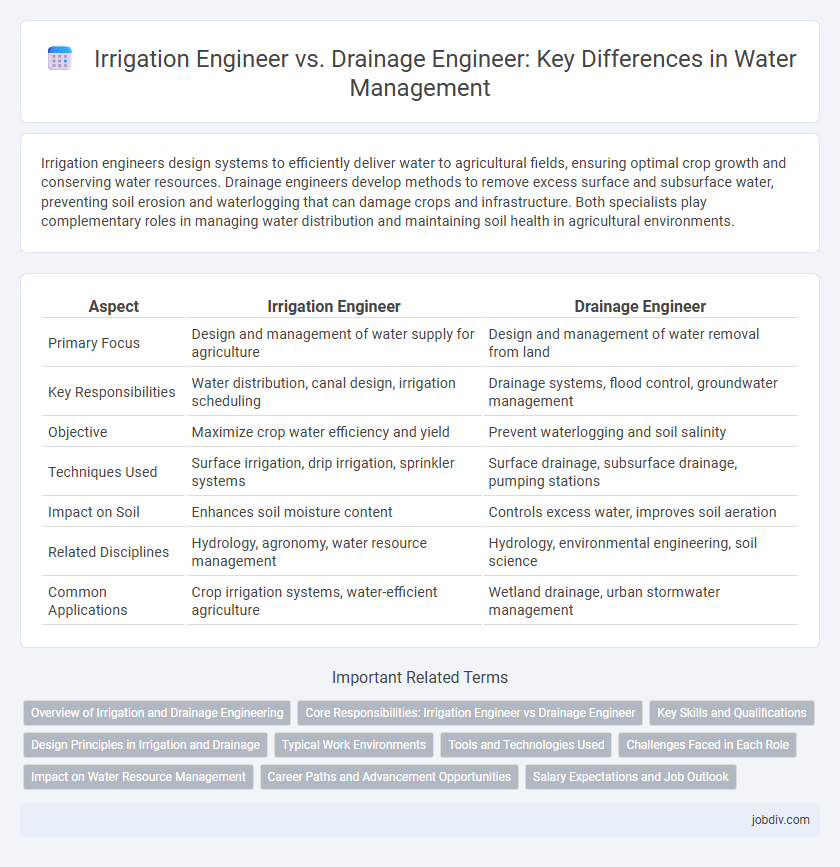Irrigation engineers design systems to efficiently deliver water to agricultural fields, ensuring optimal crop growth and conserving water resources. Drainage engineers develop methods to remove excess surface and subsurface water, preventing soil erosion and waterlogging that can damage crops and infrastructure. Both specialists play complementary roles in managing water distribution and maintaining soil health in agricultural environments.
Table of Comparison
| Aspect | Irrigation Engineer | Drainage Engineer |
|---|---|---|
| Primary Focus | Design and management of water supply for agriculture | Design and management of water removal from land |
| Key Responsibilities | Water distribution, canal design, irrigation scheduling | Drainage systems, flood control, groundwater management |
| Objective | Maximize crop water efficiency and yield | Prevent waterlogging and soil salinity |
| Techniques Used | Surface irrigation, drip irrigation, sprinkler systems | Surface drainage, subsurface drainage, pumping stations |
| Impact on Soil | Enhances soil moisture content | Controls excess water, improves soil aeration |
| Related Disciplines | Hydrology, agronomy, water resource management | Hydrology, environmental engineering, soil science |
| Common Applications | Crop irrigation systems, water-efficient agriculture | Wetland drainage, urban stormwater management |
Overview of Irrigation and Drainage Engineering
Irrigation Engineering focuses on designing and managing systems that supply water to agricultural fields, optimizing water distribution to enhance crop growth and yield. Drainage Engineering specializes in removing excess surface and subsurface water from soils, preventing waterlogging and soil salinity to maintain land productivity. Both disciplines integrate hydrology, soil science, and environmental engineering principles to ensure sustainable water management in agricultural landscapes.
Core Responsibilities: Irrigation Engineer vs Drainage Engineer
Irrigation engineers design and manage systems that efficiently distribute water to agricultural fields, optimizing crop yields through controlled water supply methods such as canals, sprinklers, and drip systems. Drainage engineers specialize in removing excess water from soil and land areas to prevent waterlogging and erosion, implementing solutions like subsurface drains, ditches, and stormwater management systems. Both roles require expertise in hydrology and soil science but focus on contrasting water management objectives--irrigation for water addition and drainage for water removal.
Key Skills and Qualifications
Irrigation engineers specialize in designing and managing water distribution systems for agricultural and landscape purposes, requiring expertise in hydrology, soil science, and hydraulic engineering. Drainage engineers focus on developing systems for efficient water removal to prevent flooding and soil erosion, necessitating skills in geotechnical engineering, environmental impact assessment, and stormwater management. Both roles typically demand a degree in civil or environmental engineering, proficiency in CAD software, and knowledge of water resource management regulations.
Design Principles in Irrigation and Drainage
Irrigation engineers emphasize water distribution efficiency, soil-water interaction, and crop water requirements to optimize irrigation design, including canal layout and scheduling. Drainage engineers focus on removing excess water from soil to prevent salinization and waterlogging, integrating subsurface drainage systems and surface runoff management. Both disciplines apply hydrological data and soil characteristics but diverge in objectives: irrigation aims to supply adequate water, while drainage ensures soil health and structural integrity.
Typical Work Environments
Irrigation engineers typically work in agricultural settings, water resource management agencies, and construction companies focused on designing and implementing irrigation systems to optimize crop water use. Drainage engineers often operate within urban planning departments, environmental consulting firms, and infrastructure development projects, specializing in managing stormwater runoff and preventing waterlogging. Both professionals frequently collaborate with government agencies and private sectors to ensure sustainable water management solutions.
Tools and Technologies Used
Irrigation engineers utilize technologies such as drip irrigation systems, automated sprinkler controls, soil moisture sensors, and satellite imagery to optimize water delivery efficiency in agricultural fields. Drainage engineers rely on tools like subsurface drainage tiles, contour mapping software, hydrological models, and automated pumps to manage excess water and prevent soil salinization. Both disciplines employ Geographic Information Systems (GIS) and remote sensing to monitor water flow and improve land-water management strategies.
Challenges Faced in Each Role
Irrigation engineers face challenges in designing efficient water delivery systems to optimize crop yield while minimizing water wastage and soil erosion, often managing variable water availability and climate change impacts. Drainage engineers confront issues related to preventing waterlogging, salinization, and flood risks by designing systems that effectively remove excess water, balancing ecological concerns and infrastructure constraints. Both roles require advanced knowledge of hydrology, soil science, and environmental sustainability to address complex water management problems.
Impact on Water Resource Management
Irrigation engineers optimize water distribution for agriculture, enhancing water use efficiency and crop yield while reducing waste. Drainage engineers focus on removing excess water, preventing soil erosion, and mitigating flood risks, which preserves water quality and protects ecosystems. Both roles are crucial for sustainable water resource management by balancing supply and preventing water-related damage.
Career Paths and Advancement Opportunities
Irrigation engineers specialize in designing systems that efficiently distribute water to agricultural fields, ensuring optimal crop growth, while drainage engineers focus on removing excess water to prevent soil erosion and flooding. Career advancement for irrigation engineers often leads to roles in sustainable water management and precision agriculture technologies, whereas drainage engineers typically progress toward environmental consulting and flood risk management positions. Both disciplines offer opportunities in government agencies, private sector projects, and research institutions emphasizing climate resilience and water conservation strategies.
Salary Expectations and Job Outlook
Irrigation engineers typically earn between $60,000 and $90,000 annually, driven by demand in agriculture and land development sectors, while drainage engineers have a salary range of $65,000 to $95,000, often influenced by urban planning and flood control projects. The job outlook for irrigation engineers grows steadily due to increasing emphasis on water-efficient farming, whereas drainage engineers face rising demand amid expanding infrastructure and climate change mitigation efforts. Both roles require expertise in hydrology and environmental engineering, with opportunities concentrated in government agencies, private consulting, and environmental firms.
Irrigation Engineer vs Drainage Engineer Infographic

 jobdiv.com
jobdiv.com